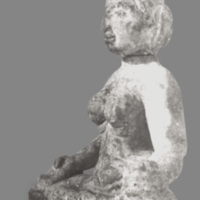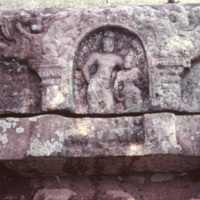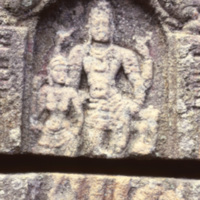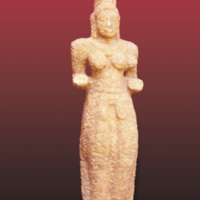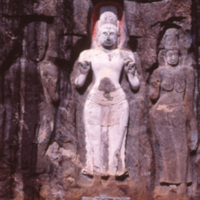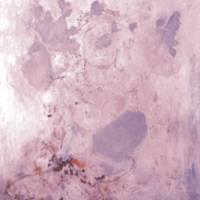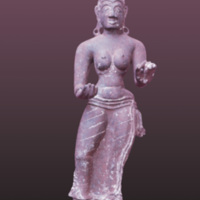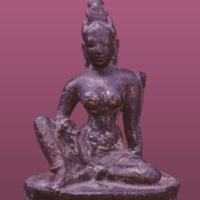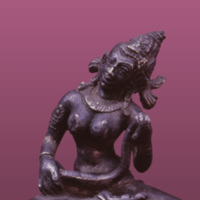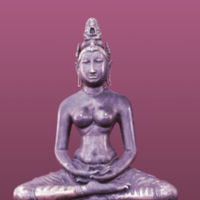Main Menu
AORC Libraries
Browse Archive Items (166 total)
Terra-cotta image of Tara
Description: That the goddess Tara finds a place in what is called the poor man’s art, can be seen from this terra-cotta image, said to be in the Archaeological Museum at Trincomalee, Sri Lanka. This slide was made from a photograph available in the Department of Archaeology in Colombo. The image probably dates to the Mahayana phase of Sri Lankan sculpture (ca. 7th to the 12th century A.D.).
Contributor: Co-Author: Seneviratna, Harsha
Collection: Women in Sri Lankan Sculpture and Painting
Stone relief, consort of Bodhisattva
Description: An image of Tara from the Vijayarama reliefs. The images in these reliefs are sometimes identified as Hindu deities. However, as they exist in a Mahayana (Buddhist) temple, the identification of Bodhisattvas and Taras seems justifiable. Copper plaques found in the precincts have invocations to the goddess Tara and the script is Sinhalese of the 8th century A.D. This is one of four reliefs at the Vijayarama Temple.
Contributor: Co-Author: Seneviratna, Harsha
Collection: Women in Sri Lankan Sculpture and Painting
Stone relief of consort of Bodhisattvas
Description: Bodhisattvas and their consorts form the subject of a number of reliefs round the stone basement walls of the Vijayarama temple at Anuradhapura, Sri Lanka, a centre of Mahayana worship of the 8th century A.D. In all these reliefs, the 4-armed Bodhisattva images are given pride of place and the female companions or Taras occupy supporting roles. Copper plaques found in the precincts have invocations to the goddess Tara and the script is Sinhalese of the 8th century A.D. This is one of four…
Contributor: Co-Author: Seneviratna, Harsha
Collection: Women in Sri Lankan Sculpture and Painting
Limestone image of Tara
Description: Also from southern Sri Lanka but of more modest proportions, is this lime-stone Tara image in the round. It was originally found in a temple at Siyambalagasvila in the Hambantota district, Sri Lanka. Displaying the usual simplicity of dress associated with Tara images in Sri Lanka, she has her hair piled up in a crowning coiffure ‘jata makuta’. The statue may belong to the 8th to the 10th century A.D. phase of Mahayana Buddhism in Sri Lanka. This sculpture is found in the National Museum,…
Contributor: Co-Author: Seneviratna, Harsha
Collection: Women in Sri Lankan Sculpture and Painting
Tara as consort of Avalokiteśvara
Description: This group of colossal Mahayana stone reliefs is seen at Buduruvagala, Sri Lanka. Standing on his left, Tara is shown as the female companion of the Bodhisattva Avalokiteśvara. The simple drapery, the lack of ornamentation and the piled up hair are among the more common characteristics of Tara images noticed at Buduruvagala, Sri Lanka too. The goddess carries a vessel in her left hand. It is dated approximately to the period between the 7th and 10th centuries on stylistic grounds.
Contributor: Co-Author: Seneviratna, Harsha
Collection: Women in Sri Lankan Sculpture and Painting
Rock painting of Tara
Description: In a different medium is this representation of Tara found painted on a rock boulder at Kotgalkanda, 8 ½ miles from Sigiriya, Sri Lanka. This is an artist's re-production of it, available at the Post-Graduate Institute of Archaeology in Colombo. Seated in an attitude of meditation, the image is barely visible in outline. She carries a water-lily, a traditional symbol of Tara. Somewhat heavily ornamented, it reflects a departure from the usual austerity associated with Tara images in Sri Lanka.…
Contributor: Co-Author: Seneviratna, Harsha
Collection: Women in Sri Lankan Sculpture and Painting
Bronze statue of Tara
Description: Among the Mahayana bronze images found at Tiriyay, Sri Lanka, is this standing statue of Tara now exhibited in the Colombo National Museum. She wears some ornaments, but on the whole there is a total lack of ostentation. This image at Tiriyay, Sri Lanka, is dated to the late Anuradhapura period (9th to the 10th centuries A.D.), when the worship of Mahayana gods and goddesses was popularly practiced according to historians.
Contributor: Co-Author: Seneviratna, Harsha
Collection: Women in Sri Lankan Sculpture and Painting
Bronze image of Tara
Description: Housed in the Archaeological Museum, Anuradhapura, Sri Lanka, is this miniature bronze of Tara seated in a partly cross-legged posture known as ‘ardhaparyanka’. Her right hand is broken and so is the flower which seems to have rested against her, of which only the stalk remains. The statue is dated to about the 9th century A.D. on stylistic grounds.
Contributor: Co-Author: Seneviratna, Harsha
Collection: Women in Sri Lankan Sculpture and Painting
Silver alloy statue of Tara
Description: This miniature silver alloy image of Tara in the Anuradhapura Archaeological Museum has been identified as ‘Janguli Tara’, the goddess who protects people from calamities such as snake-bite. She carries a cobra in her hand and has four seated Buddhas carved round her head-dress. It was discovered near Mannar, Sri Lanka. It may be ascribed to the 8th to the 10th century period, the heyday of Mahayana Buddhism in Sri Lanka according to historians.
Contributor: Co-Author: Seneviratna, Harsha
Collection: Women in Sri Lankan Sculpture and Painting
Silver statue is of Tara
Description: Originally from the Gangaramaya temple in Kurunegala, Sri Lanka, this seated silver statue of Tara. She sits in meditation, a rare pose for Tara images. Except for certain head ornaments and an empty socket in her hair arrangement which could have contained a Buddha statue, she wears no other adornments. Art historians have ascribed the image to about the 8th century A.D. on stylistic grounds. This statue is found in the National Museum, Colombo.
Contributor: Co-Author: Seneviratna, Harsha
Collection: Women in Sri Lankan Sculpture and Painting



